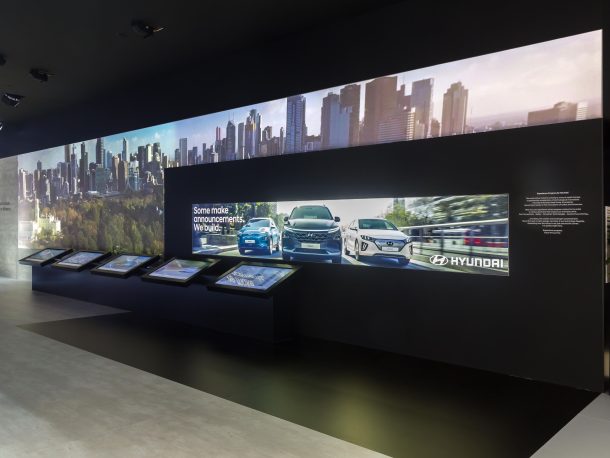How Creaplan makes its stands more sustainable
Production, transport, disassembly – stand building is known as a sector with a footprint that should not be underestimated. That is why we at Creaplan are continuously taking steps to minimise our impact. An overview of how we make our premium stands greener and more sustainable every day.
1. Modular stand building
One of the basic principles of a sustainable stand is modularity. Most of our stands are built with an aluminium skeleton. Like the blocks of a construction box, we combine walls, subfloors, ceiling elements, and frames that we can reuse for a new stand after each exhibition. With this modular building system, which lasts for years, we can build a thousands of designs, all while using the same components present in our warehouse. This way, we save on production materials and transport costs as well as reduce our waste production. For our stands with a wooden skeleton, we reuse the frames and structures as well. On top of that, the sturdiness of these components adds to the premium look of the stand.


2. Reusable decoration
Once the skeleton is built, we furnish the stand. We also regularly reuse cabinets, counters and bars, shelves, furniture, decoration, and other fixed elements. All these parts are catalogued as neutral elements in a database from which our clients can choose. Afterwards, we repair, repaint and customise them so they fit seamlessly into the stand concept and the client's branding.


3. Sustainable materials
Creaplan systematically chooses sustainable building materials.
- Painting is done with water-based paint, which is more environmentally friendly than solvent-based paint.
- Our wood is FSC-labeled and comes from responsibly managed forests.
- In addition, we choose sturdy and high-quality materials for each part of the stand. We not only do this because robust and high-end stands are our specialty, but also because these high-quality materials last longer. Less use of raw materials, less waste production, and a premium stand? Win-win-win.


4. Smart design choices
Sustainability is a constant value in the design phase. Our architects make designs which take into account the reusability of materials. For example, we present concepts that can be recycled for years, but still look new with every participation in a trade fair thanks to minimal adjustments in placement and finish. That is not only greener, but it is also more profitable for the client: you make the investment once, and get the return for several years.
In addition, we finish our stands in such a way that certain elements cannot only be reused in stands, but also in showrooms and offices. For example, our 3D logos aren't made of styrofoam or another material with a short lifespan, but from high-quality materials that last a long time. We also store all these elements in our warehouse. This way, the customer has a wide range of brand elements to choose from for each trade fair participation.




5. Integration of technology
Another way in which we limit the ecological impact of a stand is with extensive integration of innovative technology. For example, we provide numerous digital screens in the stand design for product demos or campaign images. This way, we avoid that posters with graphs, brand visuals with outdated logos, or event-specific prints end up in the bin afterwards.
Furthermore, we offer QR codes and NFC technology to digitally collect and forward as much data as possible. This technology not only eliminates the need for brochures or flyers at the stand, it also contributes to a smaller ecological footprint. If you know that Creaplan produces more than 200 stands per year, you can see how a small adjustment can have a big impact. An additional advantage is that these technologies immerse the customer even more in the world of your booth.



6. LED lighting
Sustainability is not only limited to the materials, but also includes the usage at the stand. That is why we have changed all our lighting for LEDs. This not only consumes less, but also extends the life of the lights. Bright or dimmed, in warm white or in color – we choose our lighting in a way that creates a high-quality appearance.


7. Green production
We also keep an eye on our own usage. For example, the roof of our offices and warehouse is covered with solar panels which, since they were installed in 2012, have saved about 2 million kg of CO₂. They produce about 280 MWh yearly. We can proudly say that, if the weather permits, 100% of our production runs on renewable energy.

8. Smartly devised transport
Lastly, we organise our transport as efficiently as possible. Our trucks are equipped with a fuel consumption monitor and we strive for a minimum of unnecessary kilometres. We do this thanks to our international partner network, which allows local parties to assemble stands abroad if possible. Moreover, we focus on the short chain by producing virtually everything in-house and purchasing from local suppliers whenever possible.

Ready for a more sustainable premium booth?
Creaplan guides you along the way. Get in touch for more information or get inspired by some of our creative references.